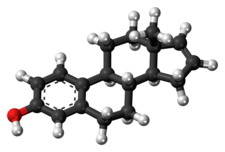Estratetraenol
 | |
 | |
| Clinical data | |
|---|---|
| Other names | Estra-1,3,5(10),16-tetraen-3-ol |
| ATC code |
|
| Identifiers | |
| |
JSmol) | |
| |
| |
| (verify) | |
Estratetraenol, also known as estra-1,3,5(10),16-tetraen-3-ol, is an
Estratetraenyl acetate, or estra-1,3,5(10),16-tetraen-3-yl acetate, is a more potent synthetic derivative of estratetraenol.[9]
Estratetraenol is an
Experiments
Experiments performed have indicated a correlation between estratetraenol and the ability to attract cooperative mates. The hormone sends olfactory signals of high fertility in pregnant and ovulating women that presents and highlights attractive qualities in those women to potential mates. These interactions between the hormone signals and males showed an increased cooperation and compassion from males to the pregnant female.[10]
Another study shows that the hormone can have an effect on how a male will approach the pursuance of a female by altering the level of sexual cognition and behavior. While the hormone increases the attractions of males to females, studies also show that it does not have an effect on the impulsive sexual nature of men when it relates to sexual desire and delayed gratification.[11]
